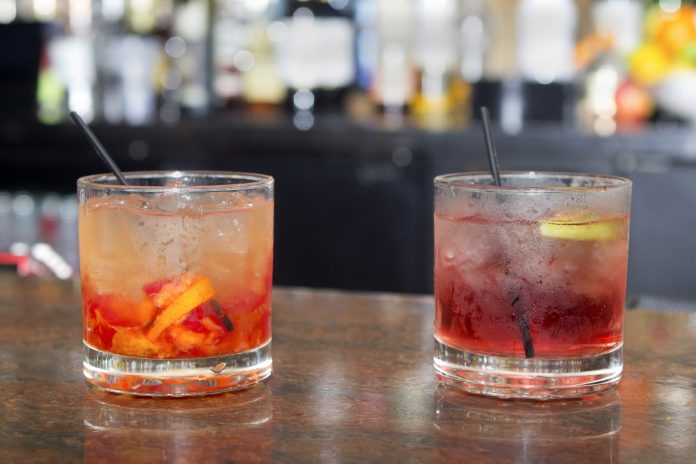If you strolled up to the rotating bar at the Club Merry-Go-Round in Youngstown during the 1940s, you’d have been handed a cocktail menu that symbolized the cornucopia of mixed drinks one could then find in bars across the country.
Drinks like the Singapore sling, Tom & Jerry, stinger and mint julep were a feature of cocktail hours everywhere.
However, the postwar years proved unkind to cocktails. By the 1980s, many of what were considered classic drinks had vanished from the collective memory of both bartenders and drinkers alike.

In the past decade, after much effort by an avant-garde of bartenders and connoisseurs, a renaissance in “craft cocktails” is now underway.
Classic recipes, made with fresh ingredients, are now joining modern classics on revamped cocktail menus in cities across the country. Drinks that were widely known at places like the Merry-Go-Round have now returned to several Mahoning Valley bars and restaurants.
“The movement towards craft cocktails, this has been going on for a number years nationally, but is much more commonplace locally now than it was five or six years ago,” says Bryan Jones, food and beverage director at Avalon Inn and Resort.
Avalon opened Gatsby’s, a restaurant and bar with a Roaring Twenties-style theme, in November 2016 in Warren. “The bars at the different Avalon properties have themes from the ‘20s, ‘30s and ‘40s,” say bartender Alex McDowell. “We’re the ones who are focused on doing Prohibition-style cocktails from that era, the classics.”
The drink menu features the bee’s knees, a gin-based drink that takes its name from the popular phrase from the ‘20s; the Daisy, a drink that some cocktail historians refer to as the predecessor to the margarita; and the aviation, a concoction that first appeared in print in 1916 and is now enjoying a renaissance.
“The bee’s knees is very popular,” McDowell says. “The aviation doesn’t get ordered as often, but if someone is adventurous enough, they’re usually pleasantly surprised by it.”
In the post-war years, vodka came to dominate bars and liquor cabinets across America. Whiskey, once the most popular spirit in America, suffered. Rye whiskey almost completely disappeared from many bars. That’s all changed, McDowell explains. Gatsby’s carries 50 different types of whiskey, including a “1920 Prohibition Style” whiskey made by Old Forester, the first bottled bourbon ever available for sale.

“Whiskey is really catching on right now, so the old-fashioneds and Manhattans are really, really big,” McDowell says.
The old-fashioned – which consists of a spirit, (usually rye or bourbon) water, sugar and bitters – meets the original definition of a cocktail. “If they say they’re a whiskey drinker, I might ask them if they’ve ever tried an old-fashioned,” he says.
But McDowell likes to put his own twist on the drink. “I use a little bit Angostura and black walnut bitters, and for the sweetener we use maraschino liqueur instead of just sugar.”
You can find plenty of twists on the classics at downtown Youngstown’s Bistro 1907, which opened in the Stambaugh Building in May. “We want the cocktails to be rooted in Prohibition-style drinks, old school cocktails from the early 1900s,” owner Mark Canzonetta says. “We make them relevant and modern for what we’re doing here.”
Drinks like the blood orange Fresno margarita and the Commerce Street – which features a combination of vermouth, gin, bourbon and ginger beer – have been especially popular with customers, says co-owner Melissa Canzonetta.
Bartenders at Bistro will pour anything you like, but they also enjoy helping customers stretch their tastes beyond what they usually drink, Mark says. “We get them out of their wheelhouse of comfort, out of the vodka and tonic with a lime, and we turn them on to a cucumber Collins, which is an amazingly fresh drink with gin and fresh cucumber juice.”
Bartenders might suggest Bistro’s Ohio maple Manhattan to a customer who enjoys the classic version of the drink, Melissa says.

The Canzonettas emphasize the importance of having a well-thought out cocktail list, and when it comes to the drink menu, her entire bar staff contributes ideas.
“I want a little bit from everyone, not just from me,” Melissa says.
The staff spent weeks tasting and experimenting with different drinks at the Canzonettas’ test kitchen. “It’s a lot of tweaking, just like a recipe for a chef,” Mark says. “Cocktails, to me, have to have a prefect balance, just like food has to have a perfect balance.”
However, a cocktail list shouldn’t be allowed to grow stale, Melissa says. “You have to have a revolving cocktail list.”
Barrel33 in Howland, a beer and wine store that features a bar and bistro, possesses one of the most impressive craft cocktail lists in the Valley, says owner Brian Fry.
“We have something for that very knowledgeable drinker, and we also have the right glass to serve the drink in, which is not something that a lot of the bars in the area can say.”
The menu features some of the oldest mixed drinks such as the mint julep and modern classics such as the black Manhattan and the songbird, which features green chartreuse, an herbal liqueur that is a favorite of cocktail connoisseurs.
While working as a bartender at places like Station Square in Liberty, Fry began to notice a change in cocktail culture.
“When I was doing it, you needed to know how to make a gin and tonic and a martini – things that are pretty easy to figure out. But it did begin to change about 10 years ago.”
Several years ago, Fry decided that he wanted to own a bar. He took a research trip to New Orleans to taste cocktails and talk to bartenders. Fry took over ownership of barrel33 in January.
“What they’re doing down there is amazing. For my money, it’s the greatest cocktail city in the world, not just the United States. We try to carry a little bit of that French Quarter stuff with us everyday in what we do.”
Just as in many bars in New Orleans, all of the juices for the drinks are squeezed fresh, Fry says. “When you’re talking about drinks that require juice, if you’re pouring that out of a can or out a bottle that’s been sitting in a cooler for six, seven days, it’s just not going to taste the same.”
Careful attention to the “craft” element of cocktails at barrel33 extends to the aging of drinks in barrels, Fry says. Whiskey lovers have the option of ordering a Manhattan that is aged for a month in a five-liter oak barrel. “There’s not a ton of those drinkers in the Mahoning Valley,” Fry says, “but those drinkers do come here, and they know when they come here that we’re going to be able to take care of them.”
Manhattan devotees and cocktail lovers will also find a home at the Speakeasy Lounge in downtown Warren, says owner Tony Schofer.
Located in the lower level of the Best Western Park Hotel, the Speakeasy’s décor pays homage to the Roaring Twenties, and many drinkers come specifically looking for Prohibition-style cocktails, says bartender Lee Simpson. “It’s interesting how times have changed since when I was younger. Now the younger crowd is going back to the classic cocktails, which to me is exciting.”
Many customers are far more educated about spirits and cocktails than they used to be, Schofer says. “With the advent of the internet and social media, people are exposed to so much more. It’s as easy to find the cocktail menu for a place in Prescott, Ariz., as it is Warren. So people have higher expectations now.”
Simpson puts his own twists on the classics. He uses a small torch to brûlée an orange with sugar for an old-fashioned. “It gives a little bit more depth to the drink,” he says.
“It’s easier to recreate then to reinvent,” Schofer says. “These are good drinks for a reason. They’ve stood the test of time.”
While many customers might be familiar with the classic recipe for a Manhattan, it’s the “perfect” Manhattan – which uses both dry and sweet vermouth – that’s featured on the Speakeasy’s cocktail menu. It’s one more way to introduce customers to a slightly different take on a treasured cocktail, Simpson says.
Yet part of the experience of drinking today, no matter what you order, is a return to the tried and true bartending techniques of yesteryear, Simpson says. “People really appreciate when you do actually craft something. When you make syrups, when you squeeze juices, when it’s fresh sweet and sour mix – people pay attention. They like that personal touch.”
© 2018 Metro Monthly. All rights reserved.





